Related Research Articles

An ammeter is an instrument used to measure the current in a circuit. Electric currents are measured in amperes (A), hence the name. For direct measurement, the ammeter is connected in series with the circuit in which the current is to be measured. An ammeter usually has low resistance so that it does not cause a significant voltage drop in the circuit being measured.

Voltage, also known as (electrical) potential difference, electric pressure, or electric tension is the difference in electric potential between two points. In a static electric field, it corresponds to the work needed per unit of charge to move a positive test charge from the first point to the second point. In the International System of Units (SI), the derived unit for voltage is the volt (V).
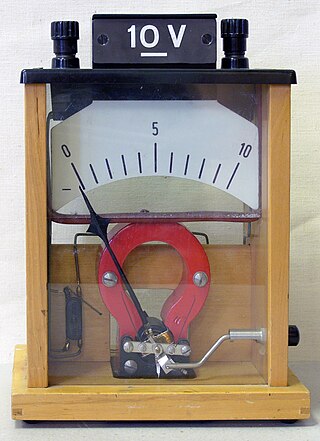
A voltmeter is an instrument used for measuring electric potential difference between two points in an electric circuit. It is connected in parallel. It usually has a high resistance so that it takes negligible current from the circuit.
The amplitude of a periodic variable is a measure of its change in a single period. The amplitude of a non-periodic signal is its magnitude compared with a reference value. There are various definitions of amplitude, which are all functions of the magnitude of the differences between the variable's extreme values. In older texts, the phase of a periodic function is sometimes called the amplitude.

A loading coil or load coil is an inductor that is inserted into an electronic circuit to increase its inductance. The term originated in the 19th century for inductors used to prevent signal distortion in long-distance telegraph transmission cables. The term is also used for inductors in radio antennas, or between the antenna and its feedline, to make an electrically short antenna resonant at its operating frequency.

Ralph Bakshi is a Palestinian-American animator, filmmaker and painter. In the 1970s, he established an alternative to mainstream animation through independent and adult-oriented productions. Between 1972 and 1994, he directed nine theatrically released feature films, predominantly urban dramas and fantasy films, five of which he wrote. He has also been involved in numerous television projects as director, writer, producer and animator.
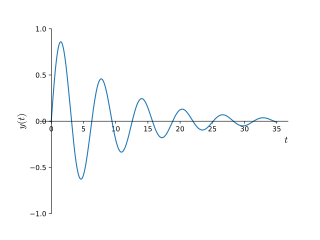
In physics and engineering, the quality factor or Q factor is a dimensionless parameter that describes how underdamped an oscillator or resonator is. It is defined as the ratio of the initial energy stored in the resonator to the energy lost in one radian of the cycle of oscillation. Q factor is alternatively defined as the ratio of a resonator's centre frequency to its bandwidth when subject to an oscillating driving force. These two definitions give numerically similar, but not identical, results. Higher Q indicates a lower rate of energy loss and the oscillations die out more slowly. A pendulum suspended from a high-quality bearing, oscillating in air, has a high Q, while a pendulum immersed in oil has a low one. Resonators with high quality factors have low damping, so that they ring or vibrate longer.
A resistor–capacitor circuit, or RC filter or RC network, is an electric circuit composed of resistors and capacitors. It may be driven by a voltage or current source and these will produce different responses. A first order RC circuit is composed of one resistor and one capacitor and is the simplest type of RC circuit.

The Lord of the Rings is a 1978 animated epic fantasy film directed by Ralph Bakshi from a screenplay by Chris Conkling and Peter S. Beagle. It is based on the novel of the same name by J. R. R. Tolkien, adapting from the volumes The Fellowship of the Ring and The Two Towers. Set in Middle-earth, the film follows a group of fantasy races—Hobbits, Men, an Elf, a Dwarf and a wizard—who form a fellowship to destroy a magical ring made by the Dark Lord Sauron, the main antagonist.
Scanning voltage microscopy (SVM), sometimes also called nanopotentiometry, is a scientific experimental technique based on atomic force microscopy. A conductive probe, usually only a few nanometers wide at the tip, is placed in full contact with an operational electronic or optoelectronic sample. By connecting the probe to a high-impedance voltmeter and rastering over the sample's surface, a map of the electric potential can be acquired. SVM is generally nondestructive to the sample although some damage may occur to the sample or the probe if the pressure required to maintain good electrical contact is too high. If the input impedance of the voltmeter is sufficiently large, the SVM probe should not perturb the operation of the operational sample.
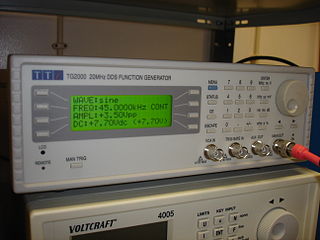
In electrical engineering, a function generator is usually a piece of electronic test equipment or software used to generate different types of electrical waveforms over a wide range of frequencies. Some of the most common waveforms produced by the function generator are the sine wave, square wave, triangular wave and sawtooth shapes. These waveforms can be either repetitive or single-shot. Another feature included on many function generators is the ability to add a DC offset. Integrated circuits used to generate waveforms may also be described as function generator ICs.
Non-Linear Systems is an electronics manufacturing company based in San Diego, California. Non-Linear Systems was founded in 1952, by Andrew Kay, the inventor of the digital voltmeter in 1954.
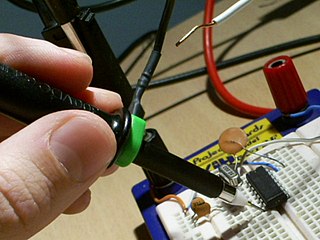
A test probe is a physical device used to connect electronic test equipment to a device under test (DUT). Test probes range from very simple, robust devices to complex probes that are sophisticated, expensive, and fragile. Specific types include test prods, oscilloscope probes and current probes. A test probe is often supplied as a test lead, which includes the probe, cable and terminating connector.
A total harmonic distortion analyzer calculates the total harmonic content of a sinewave with some distortion, expressed as total harmonic distortion (THD). A typical application is to determine the THD of an amplifier by using a very-low-distortion sinewave input and examining the output. The figure measured will include noise, and any contribution from imperfect filtering out of the fundamental frequency. Harmonic-by-harmonic measurement, without wideband noise, can be measured by a more complex wave analyser.

Erich Walther von Holst was a German behavioral physiologist who was a Baltic German native of Riga, Livonia and was related to historian Hermann Eduard von Holst (1841–1904). In the 1950s he founded the Max Planck Institute for Behavioral Physiology at Seewiesen, Bavaria.
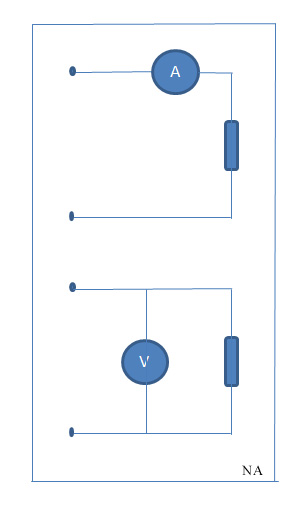
In electrical engineering class of accuracy is a figure which represents the error tolerance of a measuring device.
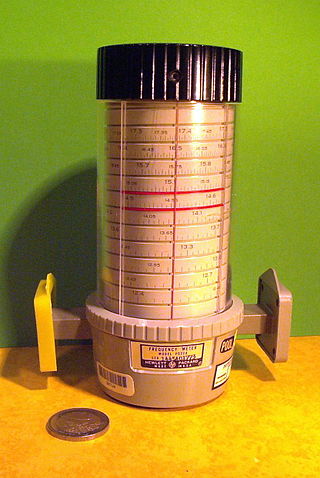
A frequency meter is an instrument that displays the frequency of a periodic electrical signal. Various types of mechanical frequency meters were used in the past, but since the 1970s these have almost universally been replaced by digital frequency counters.

The open-circuit test, or no-load test, is one of the methods used in electrical engineering to determine the no-load impedance in the excitation branch of a transformer. The no load is represented by the open circuit, which is represented on the right side of the figure as the "hole" or incomplete part of the circuit.

A double-tuned amplifier is a tuned amplifier with transformer coupling between the amplifier stages in which the inductances of both the primary and secondary windings are tuned separately with a capacitor across each. The scheme results in a wider bandwidth and steeper skirts than a single tuned circuit would achieve.
Network synthesis is a design technique for linear electrical circuits. Synthesis starts from a prescribed impedance function of frequency or frequency response and then determines the possible networks that will produce the required response. The technique is to be compared to network analysis in which the response of a given circuit is calculated. Prior to network synthesis, only network analysis was available, but this requires that one already knows what form of circuit is to be analysed. There is no guarantee that the chosen circuit will be the closest possible match to the desired response, nor that the circuit is the simplest possible. Network synthesis directly addresses both these issues. Network synthesis has historically been concerned with synthesising passive networks, but is not limited to such circuits.
References
- ↑ U.A.Bakshi, K. A. Bakshi A. V. Bakshi (2008). Electronic Measurements. Technical Publications. p. 1–24. ISBN 9788184313918.